Summary:
- In over 20 years SSTI has never generated profits or meaningful cash. Recent IPO simply allows VCs to finally exit positions. Dec 4th lockup expiration on 8 million shares
- Reams of independent data and test use confirm that SSTI ‘s technology simply doesn’t work. Period. Customers repeatedly describe overwhelming failure rate.
- Aggressive tactics by SSTI thwart release of FOIA docs to journalists and researchers. Employee testimony states SSTI provides fabricated data to law enforcement.
- Multiple recent undisclosed contract losses (just ahead of lockup expiration) and inflated 3Q revenue.
- Contracts such as Miami and Baltimore (and others) have been repeatedly announced, then quietly cancelled, re-announced, but then quietly cancelled again.
Note: This article is the opinion of the author. The author is short SSTI.
I suspect that much of the information in this article may actually come as a surprise even to certain board members. ShotSpotter has historically provided very optimistic reports to its board members, touting the unmitigated success and “proof” of its products, without including information like I have included below. A copy of one of these reports is included below.
*** SHOTSPOTTER INC. (SSTI) – KEY STATS / COMPANY DESCRIPTION
| Ticker | SSTI | LTM Rev | $21.8m | |
| FD Shares O/S | 11.69m | LTM Net Loss | -($8.3m) | |
| Mcap | ≈$200m | Cash per share | $1.65 | |
| Share price | ≈$16 | |||
| 52w Lo/Hi | $9.33 / $20.15 | Price/Sales | 9.1 x | |
Note: Share count of 11.69 million shares includes 2.05 million shares underlying deep in the money warrants and options with an average strike price of $4.55. Sell side analysts continue to ignore these 2.05 million shares.
ShotSpotter Inc. (SSTI) offers software and hardware systems which provide locational information on gunshot activity within covered areas. When someone fires a gun, ShotSpotter’s microphones detect the gunshot and send the data to a ShotSpotter center in California. It is then determined if it is indeed a gunshot. Finally, the location of the gunshot is relayed to law enforcement personnel.
*** SHOT SPOTTER INVESTMENT THESIS – SUMMARY
Below I will make clear the following points to show why ShotSpotter will quickly fall by around 80% to $2-4, once the lockup expires on December 4th.
- Uninterrupted history of failure. After a 23 year history of uninterrupted commercial and financial failure, ShotSpotter was suddenly publicly hyped in 2017 as an innovative high tech solution to gun violence, so that it could come public in an IPO by Roth Capital. For two decades ShotSpotter has had repeated brushes with outright insolvency.
- The IPO was arranged as the only exit for insiders from a business that has been unable to succeed for more than 20 years. The purpose of this IPO was simply to allow insiders and PE investors to exit an otherwise unsellable, money losing investment. On December 4th, 8 million shares will be released from lockup, allowing these investors to finally sell. Ahead of that lockup expiration, ShotSpotter juiced its revenues by pulling forward nearly$1 million of revenues from a cancelled Puerto Rico contract and then failing to disclose other contract cancellations.
- ShotSpotter. Does. Not. Work. Period. Reams of hard data prove quite conclusively that ShotSpotter simply does not work. This is why ShotSpotter has repeatedly been unable to maintain customers or generate any profits despite 20 years of trying. Actual documented success rates of less than 2%, with 70-80% of all alerts being unfounded or false alarms.
- Customers explicitly state that ShotSpotter does not work and fully confirm the hard data. New customers keep canceling. Following their cancellations, former customers confirm categorically that ShotSpotter simply does not work. Including major “trophy” contracts such as Baltimore, Miami, San Antonio and Oakland.
- ShotSpotter employee testimony (under oath) states that data presented to law enforcement is outright fabricated.
- Aggressive tactics to conceal, distort or prevent outright the release of the “damning” data. Internal memos reveal aggressive tactics by ShotSpotter to thwart FOIA requests by journalists and universities seeking transparency into government spending on ShotSpotter. Deliberate steps to legally gag police forces from disclosing the negative data. The data being withheld is the same data that categorically proves that ShotSpotter simply does not work.
- ShotSpotter fails to disclose major contract losses ahead of lockup expiration. In its November earnings call, ShotSpotter indicated clearly that only one contract had been lost. Below I show the proof that 3 more contracts have been lost but not disclosed by ShotSpotter ahead of the lockup expiration.
- ShotSpotter makes diametrically opposing statements to law enforcement, journalists and university researchers, depending on its financial interest in each situation. ShotSpotter presents one set of facts to law enforcement when selling its product to government payers. It then presents the opposite “facts” to parties trying to investigate spending on ShotSpotter and its effectiveness. ShotSpotter also presents additional “facts” which contradict its own data when marketing the product. The government payers who buy ShotSpotter are relying on the wrong data.
*** SECTION 1 – OVER 20 YEARS OF UNINTERRUPTED FAILURE AND LOSSES
ShotSpotter’s technology is not new. Neither is gun violence.
ShotSpotter’s founder, Robert Showen came up with this idea all the way back in 1994 when he kept hearing the sounds of gunfire in neighboring East Palo Alto. Over the years, there have been a few minor improvements to the technology to try to weed out more false positives (from other loud noises). But overall, the technology is still largely the same as it was 23 years ago.
Recent media headlines have been dominated by gun violence. But in fact, the US has had an epidemic problem of gun violence for decades. Despite this decades of ongoing violence, ShotSpotter has not been able to achieve any real traction, and certainly no profits for more than 20 years.
Here is a list of gun violence incidents that made major US headlines, all in 2015 or earlier. The point is that high profile gun violence has been a problem in the US for decades, yet it has not allowed ShotSpotter to ever generate a profit.
| Date | Incident | Date | Incident | |
| 12/2/2015 | San Bernardino Attack – 14 killed | 11/5/2009 | 2009 Fort Hood Shooting – 13 killed | |
| 10/1/2015 | Umpqua Community College Shooting – 9 killed | 4/3/2009 | Binghamton Shootings – 13 killed | |
| 6/17/2015 | Charleston Church Shooting – 9 killed | 4/16/2007 | Virginia Tech Massacre – 32 killed | |
| 9/16/2013 | Washington Navy Yard Shooting – 12 killed | 4/20/1999 | Columbine High School Massacre – 13 killed | |
| 12/14/2012 | Sandy Hook Elementary School Shooting – 27 killed | 10/16/1991 | Luby’s Shooting – 23 killed | |
| 7/20/2012 | Aurora Movie Theater Shooting – 12 killed | 8/20/1986 | Edmond Post Office Shooting – 14 killed | |
| 1/8/2011 | 2011 Tucson Shooting – 6 killed | 7/18/1984 | San Ysidro McDonald’s Massacre – 21 killed |
ShotSpotter has repeatedly been forced to raise new money via private placements in order stave off insolvency, with investors describing the company as “ subsisting on fumes”. At one point, ShotSpotter decided to change the direction of its business and attempt to create a“big data” play on its detection of gun shots. At the time, “big data” was the hot new thing.
That “big data” plan fizzled entirely. But the collection and analysis of the “big data” did have one result: there was now enough data gathered to prove categorically that ShotSpotter’s technology simply does not work.
This was obviously very, very bad. So ShotSpotter quickly adopted a campaign to thwart any release of that data, including blocking access for universities seeking to research it under the Freedom of Information Act.
These points are fully substantiated below. Evidence is provided via internal memos, court documents, investigative journalists and complaints by former customers.
*** SECTION 2 – THE IPO (AND UPCOMING LOCKUP EXPIRATION) AS AN EXIT FOR TRAPPED INVESTORS
After more than 20 years of providing cash infusions to keep afloat this struggling business, these private investors were finally unwilling to put in any further funds.
In March of 2017, ShotSpotter was once again down to just $2 million in cash but had debt and current liabilities of $25 million. By this time, ShotSpotter had never turned a profit and had an accumulated deficit of $89 million. As usual, ShotSpotter was again “running on fumes”.
With private equity no longer willing to fund it, in June of 2017, ShotSpotter decided to come public in an IPO led by Roth Capital.
Not surprisingly, the bankers behind the IPO are also the exact same banks who are pumping out bullish research on ShotSpotter. Roth Capital, Imperial Capital and Northland Capital.
When the lockup expires on December 4th, these are the same banks who will make millions of dollars in banking fees by running the secondary offering for the insiders to sell over 8 million shares.
Not surprisingly, each of these banks has been able to ignore the wealth of information that I present in this article. A large December fee event will no doubt provide a nice bump up in each of their year end bonuses. The support of these analysts therefore comes as no surprise.
Here is what we are hearing from Roth Capital, Imperial Capital and Northland Capital just ahead of this pending lockup expiration. So far they have made no mention of the concerns I raise below.
Imperial Capital sees +30% upside for Shotspotter
Northland Capital Markets Starts ShotSpotter (SSTI) at Outperform
ShotSpotter initiated with a Buy at Roth Capital
PT Raised to $19.75 at Imperial Capital on 3Q Report
Roth Capital Raises ShotSpotter Inc. (SSTI) Price Target to $23.00
ShotSpotter Inc. (SSTI) Given a $20.00 Price Target by Imperial Capital Analysts
*** SECTION 3 – SHOTSPOTTER. DOES. NOT. WORK. PERIOD. (THE DATA)
The data against shot spotter is absolutely and overwhelmingly conclusive. And it comes in great detail from a wide variety of completely independent sources. Each of these point to the same exact results.
As I will show in a subsequent section, ShotSpotter has undertaken significant efforts to thwart the release of any performance data for its product. This is because the data is absolutely horrific. It proves conclusively that the product provides no material benefit whatsoever.
But an investigative journalist from Forbes was able to separately obtain and analyze much of the data behind ShotSpotter. His conclusions were beyond compelling.
The data obtained by Forbes in 2016 showed that ShotSpotter provided huge numbers of alerts to law enforcement, but that more than 98% of these alerts ended in no arrests being made.
Up to 70% of the alerts were described as entirely “unfounded”.
Roughly 90% of the time, no police report was ever even filed following the alert from ShotSpotter.
Article: ShotSpotter Alerts Police To Lots Of Gunfire, But Produces Few Tangible Results
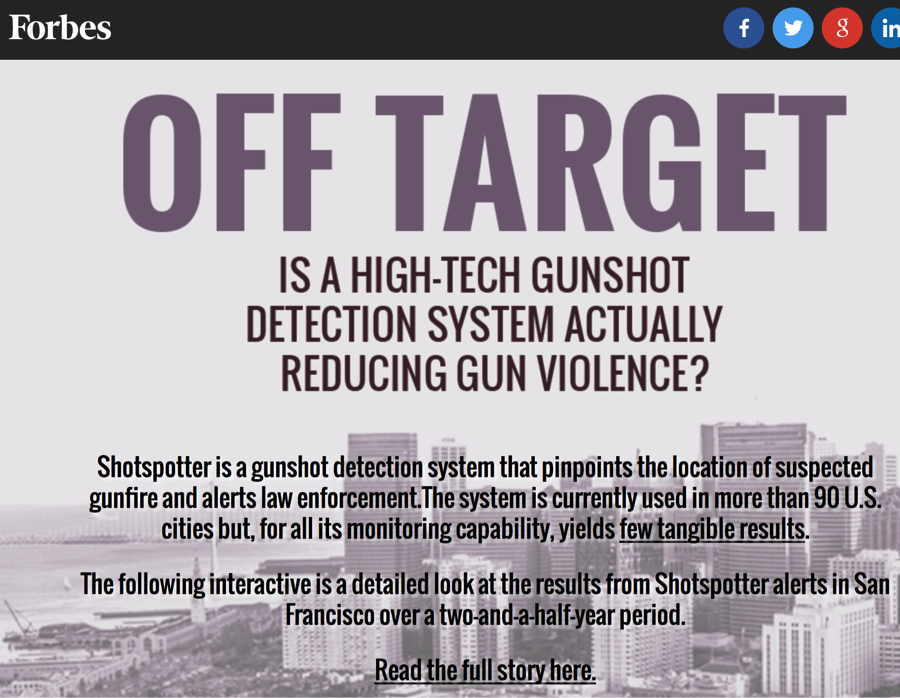
| City | Total alerts | Un-founded | % of Total | Reports taken | % of Total | Arrests | Total |
| Brockton | 296 | 152 | 51.4% | 43 | 14.5% | 2 | 0.68% |
| East Palo Alto | 1,725 | 1,089 | 63.1% | 237 | 13.7% | 4 | 0.23% |
| Kansas City | 6,619 | 2,513 | 38.0% | 714 | 10.8% | 108 | 1.63% |
| Milwaukee | 10,285 | 7,201 | 70.0% | 172 | 1.67% | ||
| Omaha | 1,181 | 737 | 62.4% | 92 | 7.8% | 14 | 1.19% |
| San Francisco | 4,385 | 1,412 | 32.2% | 76 | 1.7% | 2 | 0.05% |
| Wilmington | 1,278 | 399 | 31.2% | 256 | 20.0% | 5 | 0.39% |
And then this gets interesting.
In trying to attract and retain customers, ShotSpotter repeatedly touts the high number of alerts that its system puts out, indicating that the higher the number of alerts, the greater the benefit it is providing
But as we will see below, the high alert rate itself is actually the biggest problem, because the overwhelming majority of ShotSpotter alerts are nothing more than false alarms.
The data above is the quantitative proof which ShotSpotter has been aggressively trying to suppress from public view. It is notable that the data are highly consistent across cities of all sizes and locations within the country.
In fact, additional qualitative proof comes in the form of public statements from municipal officials and law enforcement who went on the record to publicly explain why they were abandoning this system after spending huge sums of tax payer money to have it installed.
*** SECTION 4. – “DAMNING” COMPLAINTS CONFIRMING THAT SHOTSPOTTER SIMPLY “DOESN’T WORK”.
Below I present the on-the-record comments made by law enforcement officials and government officials who have actually used and evaluated the ShotSpotter system.
What you should notice is this:
The comments below precisely echo the quantitative data above, even though they come from a wide range of totally different cities.
In addition, (just like the city data above), the verbal comments and complaints below are highly consistent among one another.
Once again, each of these cities says the exact same thing: that ShotSpotter simply doesn’t work.
The list of cities who have cancelled ShotSpotter and then publicly decried its total lack of effectiveness specifically includes cities such as Miami, Baltimore, San Antonio and Oakland. These cities have been repeatedly touted as being on the cusp of providing major revenues to ShotSpotter. But then the contracts with those cities have been cancelled or discontinued prematurely with little or no revenue at all.
#1 – Miami previously cancelled and said ShotSpotter doesn’t work
Recent headlines have indicated that ShotSpotter is on track to implement a major contract installation in Miami. ShotSpotter is a brand new IPO, so perhaps investors can be forgiven for not knowing the prior history of major contract announcements (specifically for Miami) which were then repeatedly cancelled with little or no revenue.
Local Miami media is already skeptical of the latest supposed Miami contract, because they have seen this gambit with ShotSpotter before.
Article: Should Miami-Dade Police Spend $5 Million on a Gunshot Detector They Abandoned Before?
Both the Miami Police Department and the Broward County Sheriffs Department have publicly gone on the record to state that ShotSpotter simply does not work. Worse than that, implementing the system results in a massive diversion of police resources to unfounded calls, taking officers away from actual crimes being committed.
This is why both the city and the county cancelled their previous contract. (Below we will see in greater detail the mechanics behind the repeated re-announcements of contracts that are then cancelled with little to no revenue).
In Miami, for every one verifiable gunshot, there were at least twenty false alarms. After more than a year, the system led to just four arrests.
Article: Miami Politicians Push ShotSpotter Even Though Some Local Cops Say It Doesn’t Work
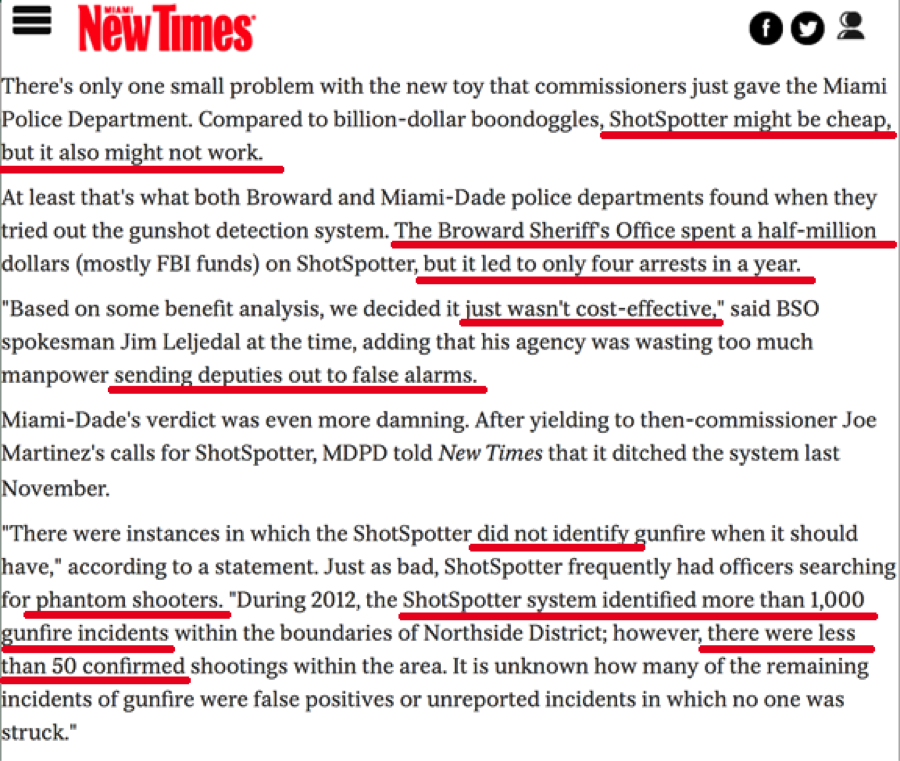
Actually this was the second time that ShotSpotter had been tried and then quickly rejected in Miami (Broward Sherriff’s Office).
Here was the first time they ditched ShotSpotter:
Article: BSO Pulling Plug On Gun Shot Spotter
According to the sheriff’s office:
They could chalk up only four arrests to the system compared to the many man hours wasted by deputies checking out false alarms.” Apparently, ShotSpotter could not distinguish between “gunshots, firecrackers, vehicle backfires or big trucks downshifting on nearby I-95.
#2 – Baltimore cancelled and said ShotSpotter doesn’t work
Just like Miami, we have seen multiple public announcements trumpeting a ShotSpotter contract for Baltimore. These reports were actually entirely wrong, but few people ever saw the quiet corrections down the road.
As with Miami, despite some flashy news in 2017, Baltimore had already tried, evaluated and then cancelled ShotSpotter on two separate prior occasions.
In February of 2014, SSTI posted to its web site a very prominent post highlighting that the Baltimore police department would be implementing ShotSpotter. This announcement was exceptionally high profile because by this time the gun violence crisis in Baltimore had already surpassed Chicago in severity.
ShotSpotter website: Baltimore Police to Invest in Gunshot Detection System
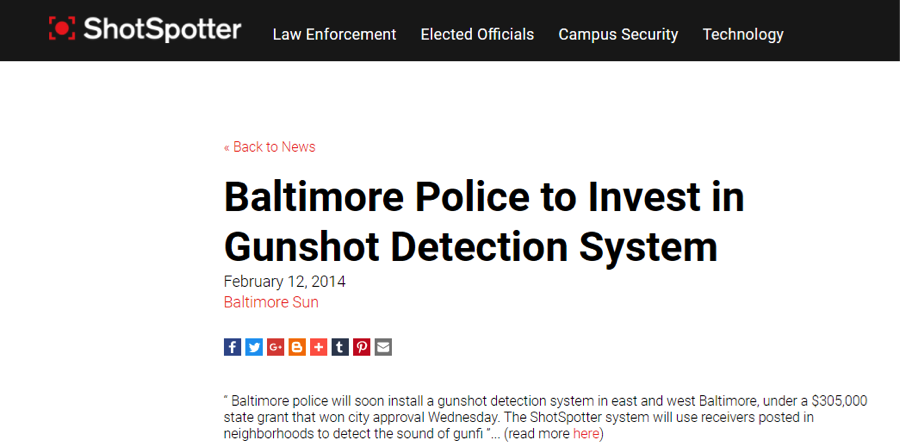
It took until a full year later, but we finally found out that this post was not only grossly premature, but it also turned out to be completely wrong.In fact, a full year later we found that this contract never went in to place at all in 2014 and that it would not be doing so going forward. In other words, in 2014 this information was so preliminary that it should have never been posted by the company at all. And in the end it turned out to be just flat out wrong. The contract had never even happened in the first place a full year earlier.
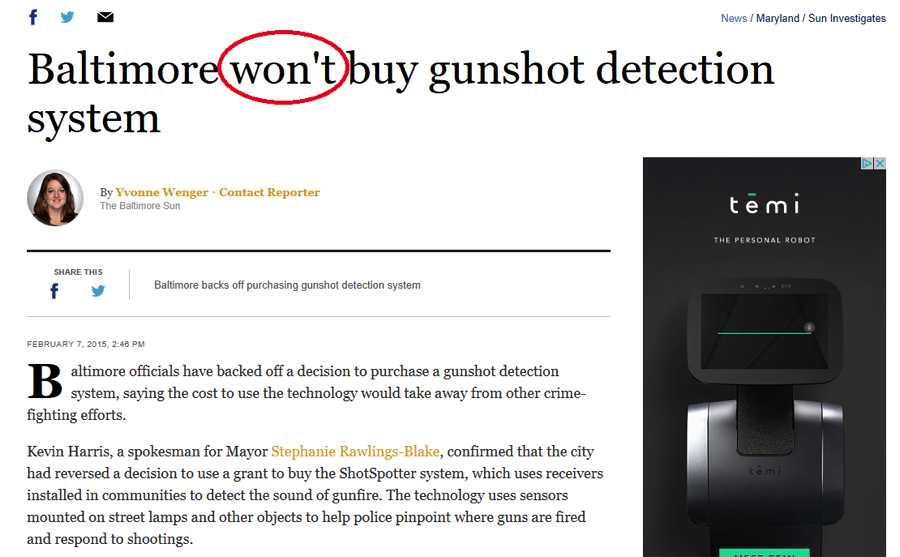
Article: Baltimore won’t buy gunshot detection system

We can see from Baltimore the consistent complaint from law enforcement. Not only does ShotSpotter not work, but implementing it actually causes even larger problems. As shown above, Baltimore stated that:
the fight against crime would be adversely affected by proceeding with the system.
In 2017, Fake News announces a Fake Contract for Baltimore. SSTI shares spike higher.
And yet despite this obvious past conclusion, investors quickly fell for the same old gag when it was announced (yet again) in 2017 that Baltimore would once again adopt the system.
Article: As murder rate soars, Baltimore Mayor Pugh seeks help from Gov. Hogan

The share price of ShotSpotter immediately spiked by 10%. Few investors noticed when that “news” was quietly retracted a few days later in a tiny note at the bottom of that same article.
Retraction: Baltimore police will expand gunshot detection, get more laptops for police cars – Technical.ly Baltimore

#3 – Charlotte cancelled and said ShotSpotter doesn’t work
In 2016, Charlotte refused to renew its contract with ShotSpotter, after having used the system for four years. More important were the comments that Charlotte police made at the time, noting that:
the gunshot detection system didn’t help them makes arrests or identify crime victims.
Article: Charlotte ends contract with ShotSpotter gunshot detection system
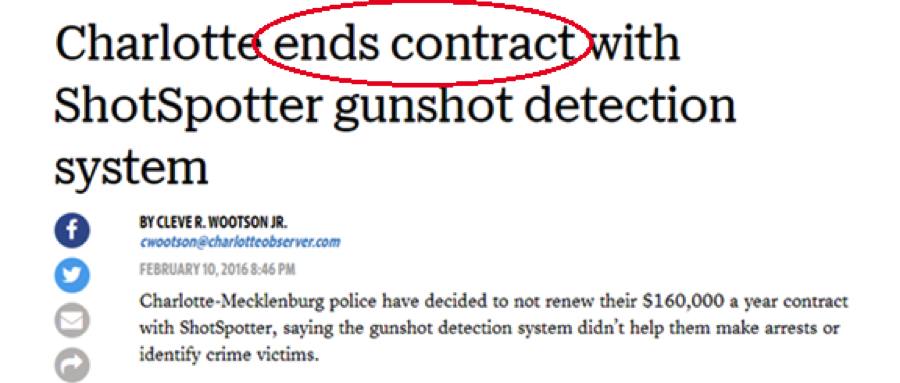

From the above:
Police were only able to find evidence of a gun being fired in one out of 41 reports.
#4 – Oakland cancelled its expansion and has said ShotSpotter doesn’t work
The city of Oakland has been described as the “third most dangerous city in America”.
But in a review of ShotSpotter, Oakland police were quoted as calling the “ technology as not only ineffective, but also counterproductive.”
Article: Oakland cops aim to scrap gunfire-detecting ShotSpotter
Oakland police have also called the system:
expensive and redundant…They say residents already call to alert police when they hear gunfire, and the money could be better used to fund other technology, such as the police helicopter.
Keep in mind, that Oakland is right in the backyard of ShotSpotter and its founders.
As of recent quarters, Oakland was still a partial customer of ShotSpotter.
On the recent conference call on November 7th, ShotSpotter indicated clearly that aside from Puerto Rico/Virgin Islands, there had been no other contract losses.
But as far back as April 28, 2017 the city of Oakland had already publicly disclosed that it was discontinuing its expansion of ShotSpotter. Phase I had already been implemented, but Phases 2 and 3 have now been cancelled. As is always the case, the part actually implemented was small, while the majority of the previously announced contracts were actually cancelled without providing the “expected” revenue to ShotSpotter.
In fact, given the public statements to the press by Oakland police, these cancellations really should have come as no surprise whatsoever.
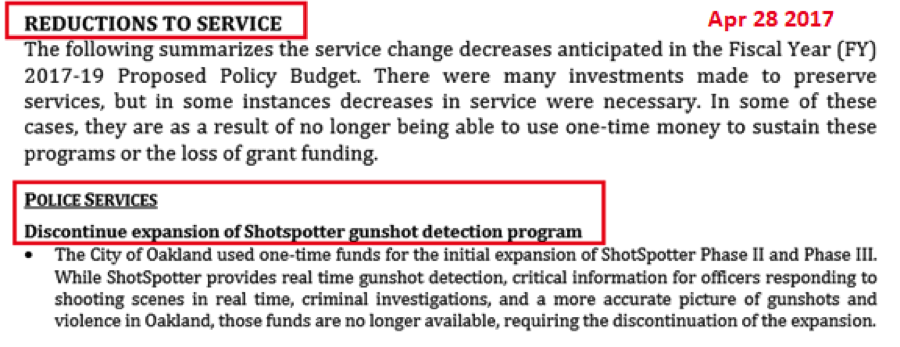
Link: Oakland Budget – Apr 2017
Clearly someone in the Oakland municipal government has a favorable opinion of ShotSpotter. But in fact, the police have actually been trying to scrap the program for years – since 2014. In its attempts to keep Oakland from cancelling their entire program, ShotSpotter then slashed its fees dramatically.
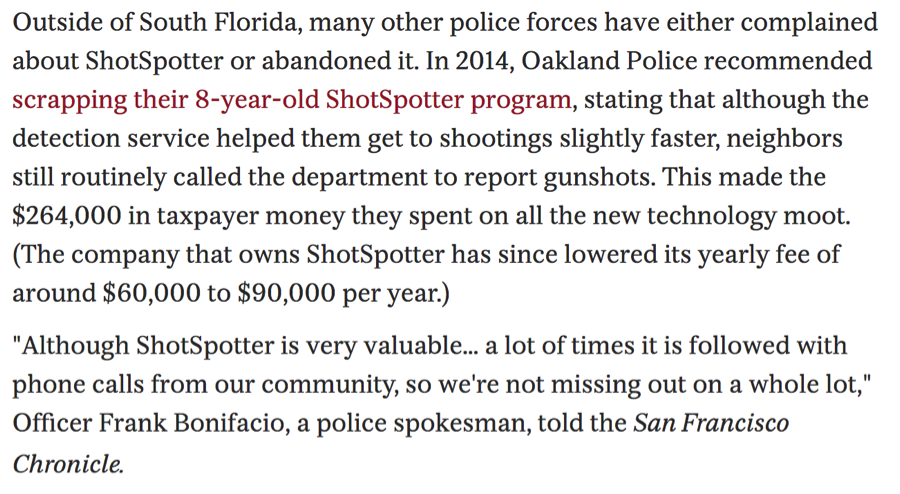
Article: Link
#5 – San Antonio cuts ShotSpotter and said it doesn’t work
As shown below, although ShotSpotter has publicly indicated that it hasn’t lost any major contracts other than Puerto Rico/Virgin Islands, the company’s San Antonio contract has already been lost in recent months.
In October 2016, SSTI announced that ShotSpotter was expanding into eight new areas, San Antonio being one of them.
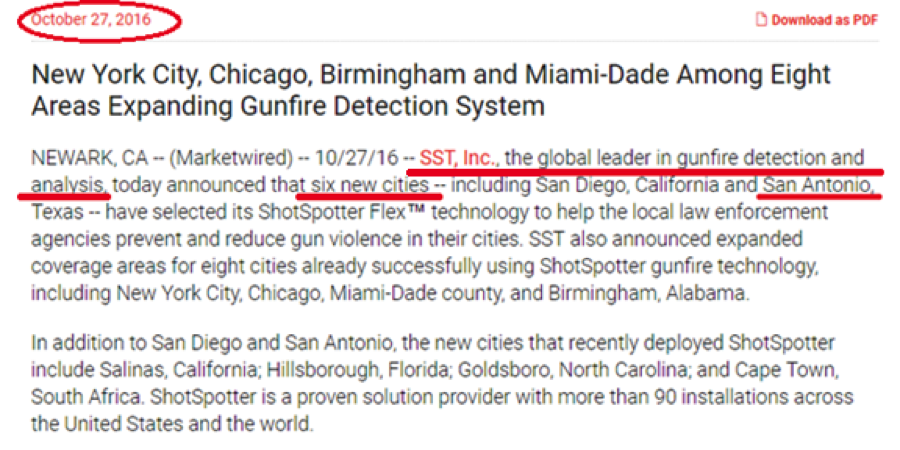
ShotSpotter IR: New York City, Chicago, Birmingham and Miami-Dade Among Eight Areas Expanding Gunfire Detection System
Just 10 months later, however, San Antonio cut funding for ShotSpotter citing the high cost against the fact that there were only 4 arrests made.
 Link: S.A. cuts funding to $550K gunshot detection program that resulted in 4 arrests
Link: S.A. cuts funding to $550K gunshot detection program that resulted in 4 arrests
According to the assistant to the SAPD Police Chief:
about 80 percent of the times when ShotSpotter was activated, police could find no evidence of a shooting at the scene…
The San Antonio Police made it very clear why they were cutting ShotSpotter.The system simply didn’t’ work.
Over the course of 15 months, the system only resulted in a mere 4 arrests – at a cost over $136,500 per arrest !
In their own words, San Antonio Police summarized the system well:
- “It doesn’t make the community feel safer”
- “It doesn’t reduce the number of gunshots in our community”
- “It doesn’t prevent you from being shot.”
In other words, the only party to benefit from the massive tax dollars spent on ShotSpotter is….well….ShotSpotter itself.
Article: San Antonio police cut pricey gunshot detection system

#6 – Fall River cancelled and said ShotSpotter doesn’t work
Fall River is another interesting example.
The question is this: Did ShotSpotter lose the Fall River contract or not ?
On the one hand…it is true that Fall River continues to use the ShotSpotter product.
But on the other hand…after Fall River recently canceled their contract, ShotSpotter just now started providing Fall River with the service for FREE.
Clearly the contract that ShotSpotter had signed with Fall River required payment for the service and clearly those payments are no longer being made. In other words, “Yes”, the contract has been cancelled. But “No” the loss of this contract has not been announced by ShotSpotter. In fact, the data provided by ShotSpotter on November 7 th clearly indicated that aside from Puerto Rico/Virgin Islands, no other contracts had been lost.
For now, ShotSpotter has offered to continue to provide free service to Fall River such that it feels that it does not need to disclose the contract loss until after the lockup. Very convenient !
But here’s the rub: once the lockup expires on December 4 th SSTI will have no more reason to lose money by proving free service to non paying customers. I expect that at that time the cancellation of the contract will finally be announced.
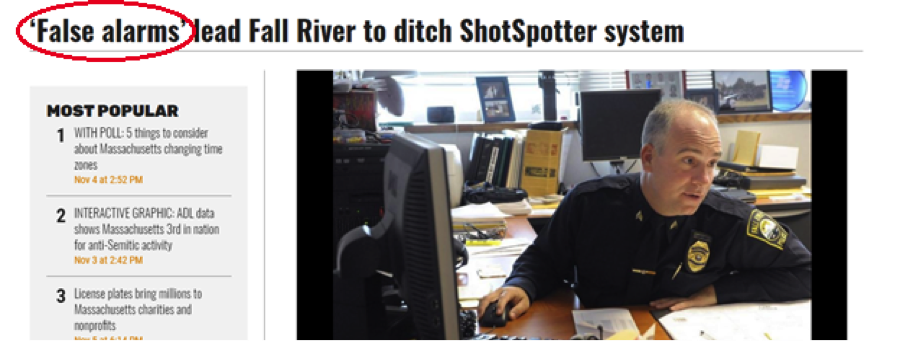
Article:‘False alarms’ lead Fall River to ditch ShotSpotter system
Along with a 41 percent false alarm rate and an expensive price tag, Fall River police have reported that there have even instances where ShotSpotter failed to report gunshots in locations where the sensors were located.
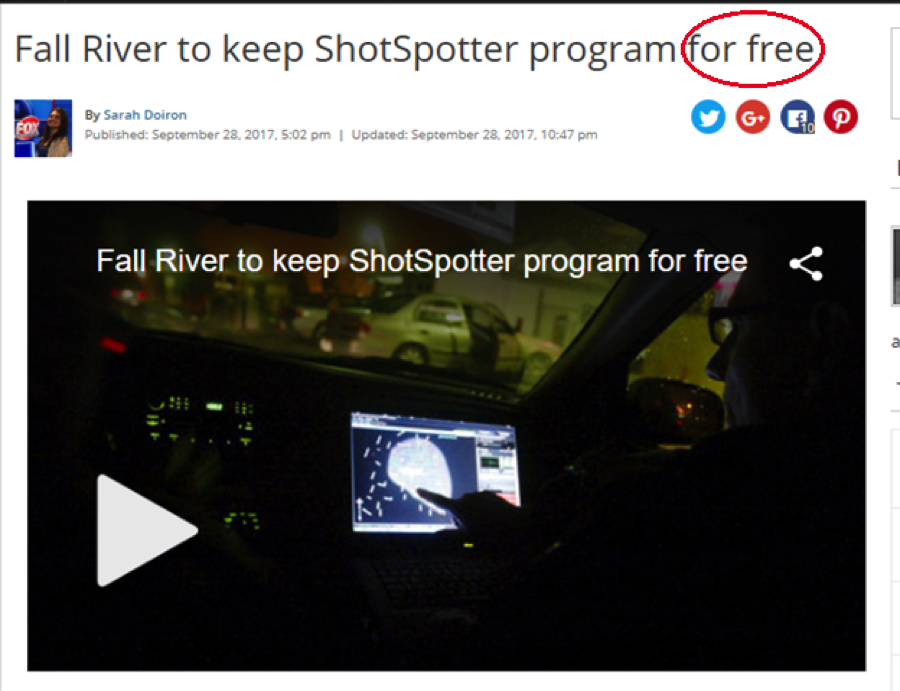
Article: Fall River to keep ShotSpotter program for free
#7 – Troy,MI cancelled and said ShotSpotter doesn’t work
Yet another former customer who discontinued its contract with ShotSpotter is the city of Troy, who discontinued its contract in 2012.
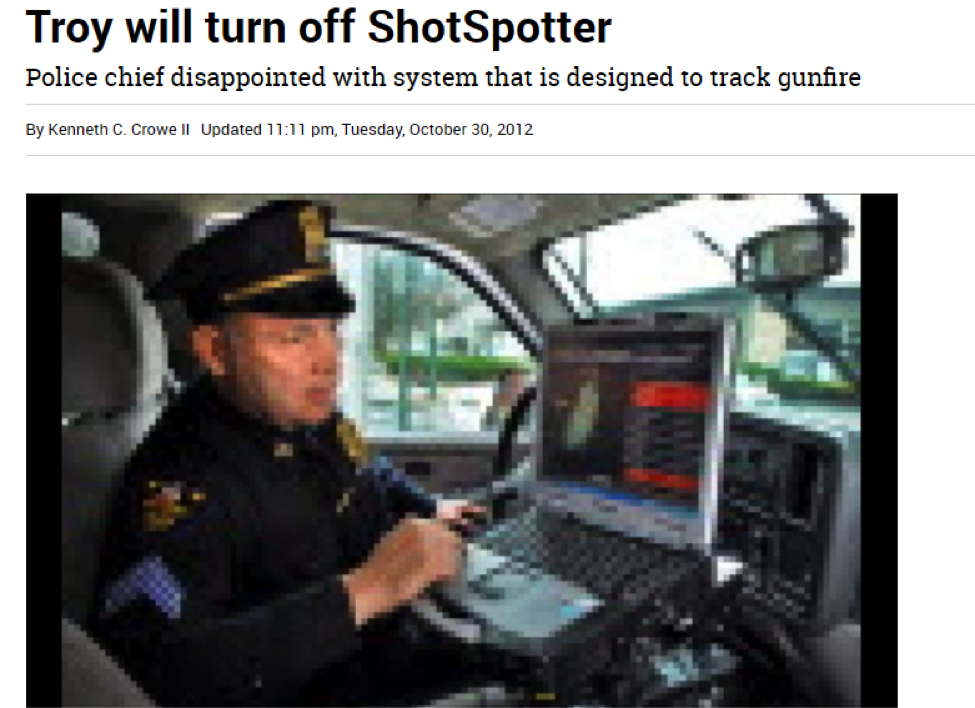
Article: Troy will turn off ShotSpotter
According to the Troy police department, “The system was suppose to become attuned to the way sounds were heard in Troy’s streets and differentiate among the brakes of a truck climbing the Hoosic Street hill, from a firecracker, actual shots and any other noise.” These attributes were “never completely achieved.”
*** SECTION 5 – SHOTSPOTTER EMPLOYEE TESTIMONY STATES DATA PROVIDED TO LAW ENFORCEMENT IS OUTRIGHT FABRICATED
SSTI employee Paul Greene is a “Manager of Forensic Services at SST Inc.,” according to his LinkedIn page.
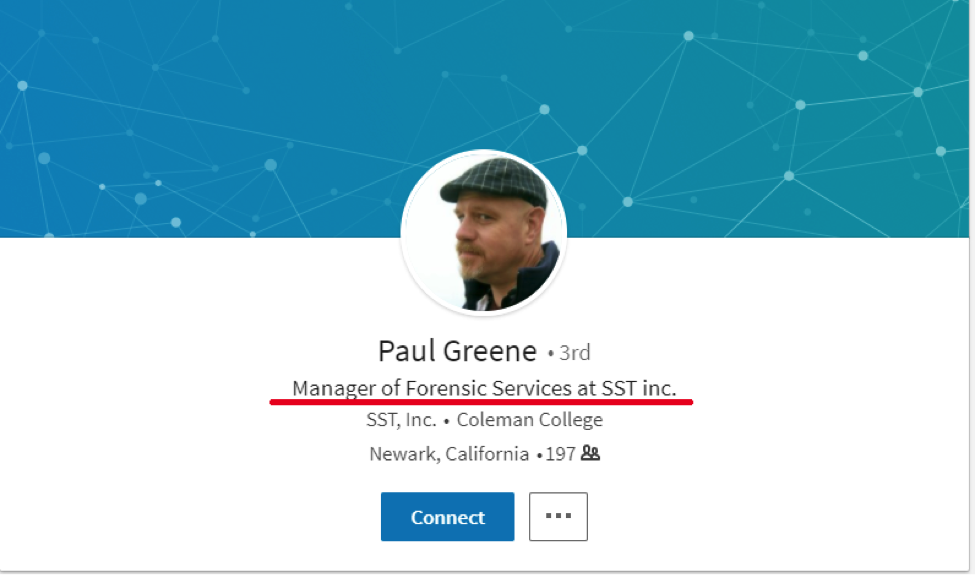
Testifying under oath in the Reed trial, which was brought about after a man (“Reed”) shot at a car full of people in 2016, Paul Greene was questioned about the accuracy of the ShotSpotter system.


In addition, in a prior deposition, Greene revealed that ShotSpotter has faced at least five separate court challenges to the validity of the science behind it.
Why was Paul questioned in the first place ? The ShotSpotter system alerted police to a location that was a full city block away from the actual shooting.
Article: Courtroom testimony reveals accuracy of SF gunshot sensors a ‘marketing’ ploy
Some members of law enforcement are already catching on to ShotSpotter’s “marketing” ruses.
Last year, Memphis police deputy chief Jim Harvey posted on his LinkedIn page a request for feedback on ShotSpotter. Instead, he was inundated with feedback from various people with various direct and indirect ties to ShotSpotter itself
According to Forbes, here is what happened:
Article: ShotSpotter struggles to prove impact as silicon valley answer to gun violence
*** SECTION 6 – INTERNAL MEMOS: MANAGEMENT AGGRESSIVELY CONCEALING AND OBSCURING THE OVERWHELMING EVIDENCE
In order to attract new customers, ShotSpotter has implemented an aggressive campaign to suppress and conceal all of the negative information about the product.
At the same time, ShotSpotter aggressively supplies these officials with a deeply misleading sub-section of statistics to allow them to tout how it is in fact tremendously effective!
The Freedom of Information Act (“FOIA”) was passed in 1967 to provide transparency into the workings and decisions of government so as to avoid fraud and waste.
From the website FOIA.gov

Internal memos from ShotSpotter reveal the aggressive tactics that ShotSpotter is using to thwart the release of data under FOIA
FOIA allows for several exceptions including for law enforcement, public safety, and trade secrets. In fact, the only “secret” that ShotSpotter is trying to protect is the fact that its product simply doesn’t work and that it is a waste of federal and local tax dollars.
In internal memos, ShotSpotter is not shy about saying that the purpose of withholding this information is to protect its own business from “harm” that would be caused by releasing the data.
ShotSpotter instructs recipients to:
#1 – simply refuse to release, or
#2 – release data that is heavily redacted to not show the terminal flaws shown above
#3 – “ Obscure” the most important information
And then even when any information is actually released, ShotSpotter has specifically instructed its recipients to deliberately provide only paper copies of the heavily redacted information so as to further thwart dissemination online by anyone.
The screenshot below is a “ Customer Success Training Bulletin” circulated by ShotSpotter.
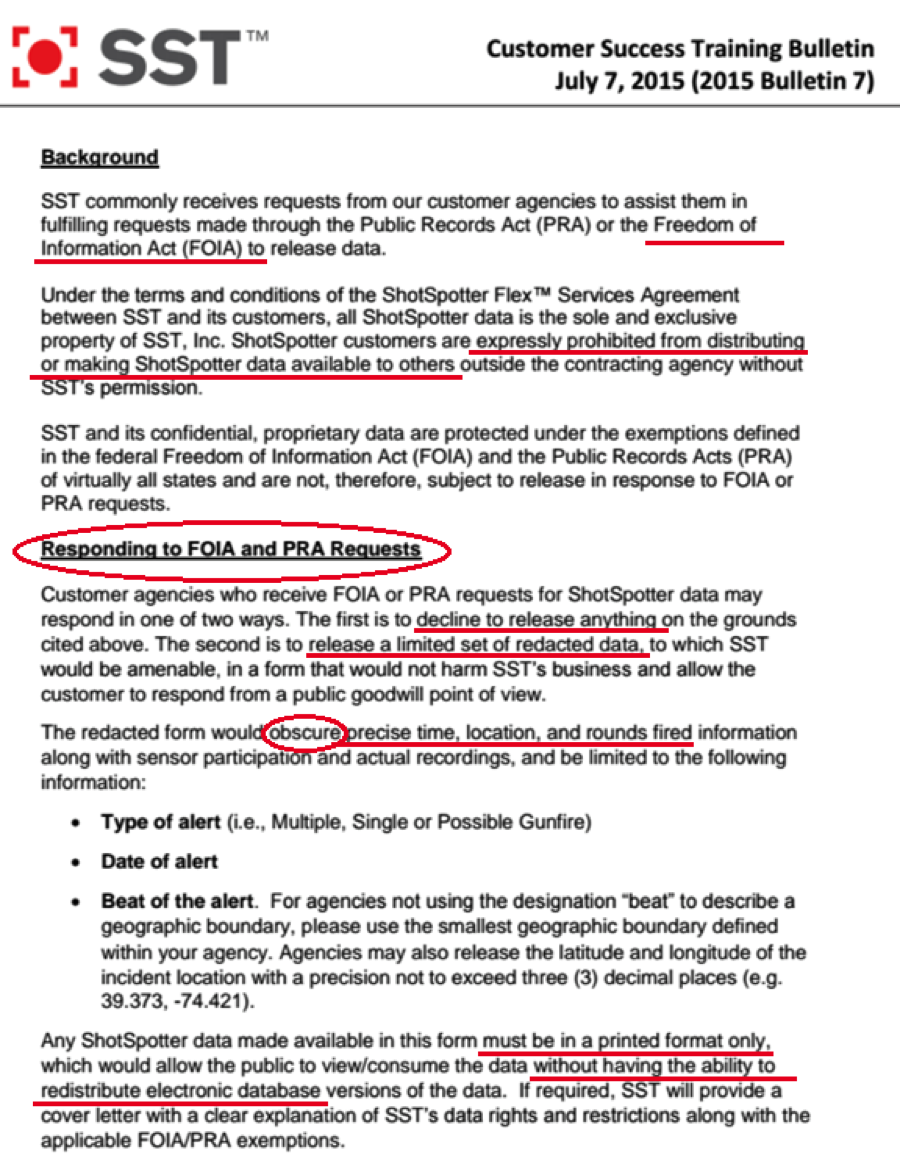
Notably, ShotSpotter is more than happy to release data which simply shows the huge number of raw alerts. This information is then used for marketing purposes.
The grand irony here is that it is precisely this excessive number of false alerts that is precisely the reason why ShotSpotter is so ineffective and wasteful of public resources. But because ShotSpotter deliberately stymies the release of the full data set, this large number of alerts actually looks like a net positive for the system. As a result, no one is the wiser.
Below I show repeated examples where ShotSpotter actively promotes itself based on the notion that “a high number of alerts equals a higher level of public safety”.
Some of the data below has been released directly from ShotSpotter’s web site. Other material has then been re-disseminated through third party sites which quote the original data being put out by ShotSpotter.
- ShotSpotter Reports Nearly 75,000 Published Gunfire Incidents in U.S. Cities Monitored in 2016, Compared to 54,699 in 2015 “ In 2016, ShotSpotter’s analysts confirmed more than 80,000 gunshots and they expect to exceed that figure this year as they expand.”
- “ Total Number of Published Gunfire Incidents: 74,916; Per Day: 205.2; Per Hour: 8.6”“ ShotSpotter’s coverage is most extensive in the eastern half of the city. By the quadrant, the network has captured 18,700 incidents in Southeast, 10,600 incidents in Northeast, 6,400 in Northwest and 1,600 in Southwest…The network has logged an additional 1,600 shootings along the edges of the city.”
- “ In Q4 2014 there were 16,597 incidents in ShotSpotter coverage areas, and of those, 3,556 (or 21.4%) took place during the New Year’s Eve period.”“ In 2014 there were 33,975 separate gunfire incidents in the 47 cities measured. That translates to 105 gunfire incidents per day, or 4.4 incidents every hour – just in ShotSpotter-protected areas of the 47 cities.”
- “ During the first half of 2014, SST reported 11,675 gunfire incidents occurred in the 107.6 square miles in those areas; down from 14,703 in the same period in 2013 over 98.6 square miles.”
Selling the board of directors:
These are the exact type of stats that ShotSpotter management feeds to its board members in periodic “progress reports”. The reports contain very brief “news” articles which read more like press releases and contain heavy amounts of data supplied directly by ShotSpotter itself. They also contain lengthy “ case studies” which were written by management to tout success stories. But in reading the “case studies” more closely, it becomes interesting to observe the large number of “satisfied customers” who then canceled their contracts subsequent to the date of the report.
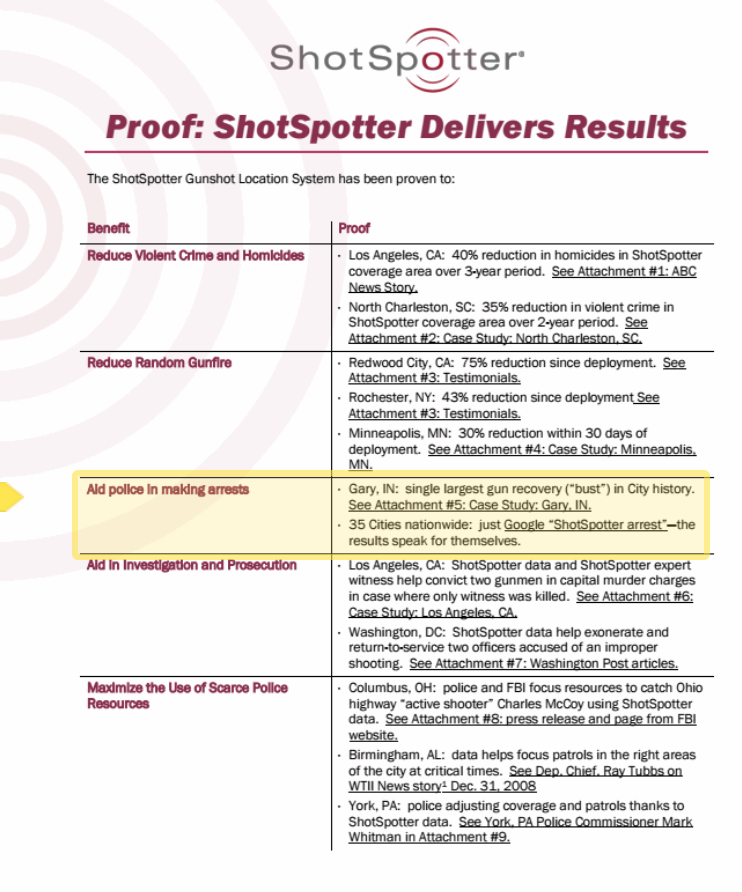
Link: Full document
The point is this: ShotSpotter actively promotes its product on the basis that “more alerts equates to greater public safety”. In fact, as we can see from the data and the customer complaints, the exact opposite is true. The biggest problem is that ShotSpotter results in false alerts as much as 70-90% of the time. But because ShotSpotter has largely concealed the data, the public and the government payers may not know until after they use and then cancel the system.
*** SECTION 7 – SSTI FAILS TO DISCLOSE MAJOR CONTRACT LOSSES AHEAD OF LOCKUP EXPIRATION
News of each of these contract cancellations occurred in time to be included in ShotSpotter’s November 2017 earnings release.
Despite this, ShotSpotter has not disclosed any of these cancellations.
In some cases, in response to cancellation, ShotSpotter has taken to “giving the service for free” to delay reporting the cancellation until after the lockup expires. But the fact is that such customers already announced their cancellation and are no longer paying ShotSpotter.
Also, keep in mind that these are just the ones I have already found. There may be additional undisclosed contract losses that I have not yet found. But I will continue looking, of course.
On the earnings call on November 7th, the comments made by CEO Ralph Clark made it very clear that aside from Puerto Rico/Virgin Islands, the company had not lost any other contracts.
Puerto Rico was important because it was ShotSpotter’s 2 nd largest customer accounting for 10% of revenues. It was a big loss, but at least it was (according to the CEO) the only loss.
We can see this from the Q2 transcript.
CEO Clark stated that net new miles gone live in the quarter was only 17. The total gross new miles was 50. But Clark stated clearly that the number of square miles lost in Puerto Rico/Virgin Islands was exactly 33.
In other words, ahead of this key lockup, Mr. Clark has made it very clear that aside from Puerto Rico/Virgin Islands, ShotSpotter has not lost any other customers. This information has clearly provided strong support to the stock price just ahead of the lockup expiration where insiders can finally sell their shares.
Cancellation #1 – San Antonio. Newspaper articles from as far back as August 2017 were already noting that San Antonio was cancelling its contract. They were quite clear in stating their reasons why:
Specific quotes from San Antonio Police include:
- about 80 percent of the times when ShotSpotter was activated, police could find no evidence of a shooting at the scene
- the system only resulted in a mere 4 arrests – at a cost over $136,500 per arrest
- “It doesn’t make the community feel safer”
- “It doesn’t reduce the number of gunshots in our community”
- “It doesn’t prevent you from being shot.”
Article: San Antonio police cut pricey gunshot detection system (Aug 2017)
Even though this cancellation (and the reasons why) could be found as early as 6 months ago, ShotSpotter has recently continued to insist that the only lost contract was Puerto Rico.
Cancellation #2 – Fall River. As we also saw above, Fall River, MA is no longer paying for the service, but ShotSpotter is continuing to provide the service for free so as to not disclose the loss of the contract ahead of the lockup expiration.
Article: Fall River to keep ShotSpotter program for free (September 2017)
ShotSpotter has agreed to let the city of Fall River continue to use the system for free, Mayor Jasiel Correia announced Thursday.
Cancellation #3 – Oakland, CA
As far back as April 28, 2017 the city of Oakland had already publicly disclosed that it was discontinuing its expansion of ShotSpotter. Phase I had already been implemented, but Phases 2 and 3 have now been cancelled. As is always the case, the part actually implemented was small, while the majority of the previously announced contracts were actually cancelled without providing the “expected” revenue to ShotSpotter.
In fact, given the public statements to the press by Oakland police, these cancellations really should have come as no surprise whatsoever.
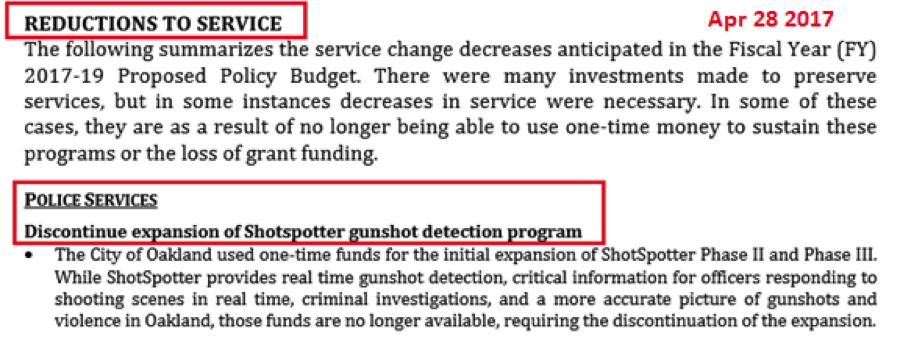
*** SECTION 8 – SHOTSPOTTER MAKES CONTRADICTING STATEMENTS TO LAW ENFORCEMENT VS. JOURNALISTS AND UNIVERSITY RESEARCHERS
In fact, beyond this deliberate distortion of the data above, ShotSpotter goes much further in disseminating information that is flat out incorrect.
We can see repeated examples where ShotSpotter gives one set of facts to law enforcement customers but then gives contradicting “facts” to researchers and journalists who are investigating the use of ShotSpotter.
Here are 3 examples:
Example #1 – “Alternative facts” on crime data
Jennifer Doleac is an assistant professor of public policy and economics at the University of Virginia who attempted to get her hands on the data underlying ShotSpotter to assess whether it actually works and if it is a sensible use of tax dollars.
ShotSpotter adamantly rebuffed any and all efforts to obtain the data for analysis. When Ms. Doleac requested the information citing that the data was a matter of public interest – crime data – Mr. Clark sent her a strongly worded letter insisting that ShotSpotter was now a “Cloud based services model” and specifically that SST’s ShotSpotter data is NOT crime data”.
Obviously this statement from Clark defies common sense. We know that any data related to urban gunfire is going to be crime data.
This statement by ShotSpotter CEO was a convenient excuse for the company to suddenly refuse to release the data which would prove that the product is a waste of taxpayer dollars.
As shown in the examples below, ShotSpotter has consistently described its data as crime data when that served a useful marketing purpose. But when the release of “crime data” became a threat to ShotSpotter became a threat, the CEO simply changed his story.
From ShotSpotter’s website:
Law enforcement is no longer dependent on 911 calls with ShotSpotter because it instantly notifies officers of gunshot crimes in progress with real-time data.
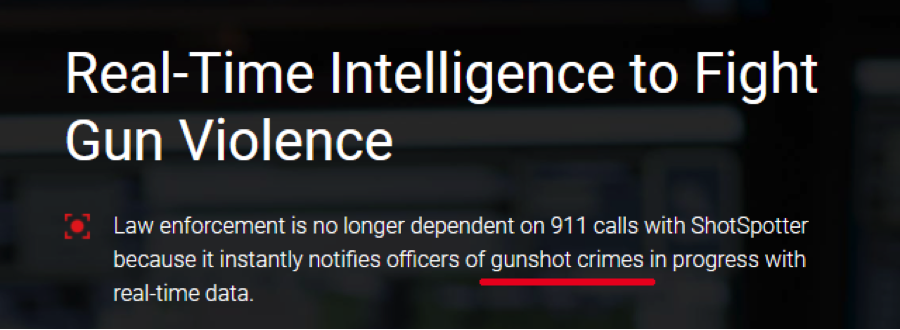
From ShotSpotter’s brochure: “ Key Benefits: … Proactive gun crime pattern analysis & strategic deterrence.”
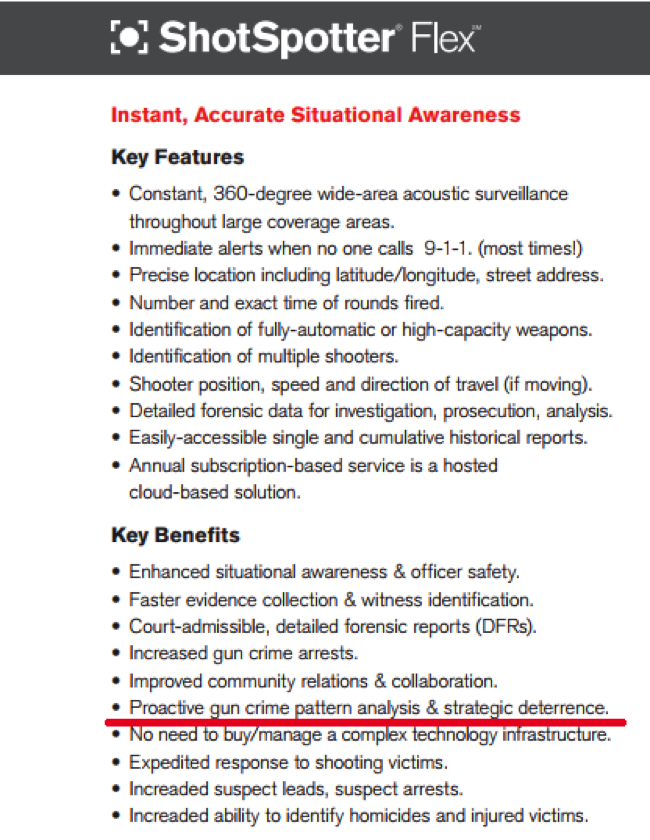
The point is this: In trying to sell its product to government payers, ShotSpotter repeatedly highlights the value of its crime data. But as soon as it fears it will have to turn the data over to independent investigators in FOIA requests, ShotSpotter simply claims that this data is no longer “crime data”. ShotSpotter will say anything (even contradicting its own earlier statements) to prevent the release of the reams of data which prove that the product does not work.
Example #2 – Because ShotSpotter doesn’t work, the company invents new metrics in order to sell the product to new cities.
ShotSpotter clearly doesn’t work in even remotely the way it is marketed. We can see that from the raw data as well as the detailed comments from law enforcement across the country. We can also see it in various court documents and investigative articles.
We know from the data and complaints above that ShotSpotter doesn’t improve public safety or reduce gun violence. In the vast majority of cases, the system can’t even determine if any shot was fired at all.
So instead, ShotSpotter has taken to inventing new “success objectives” for the use of its product.
Even if there are no arrests or other public safety benefits, ShotSpotter tries to convince the public that there is some benefit to things like:
finding shell casings well after the fact“sending a powerful message to law abiding citizens”“ better community relations”“ enhanced situational awareness”
ShotSpotter IR: Dozens of Shell Casings Found in Two Separate Shootings
[ Clark] said he wondered if the department was defining success in the wrong way.
ShotSpotter allows police to make a quick response to gunfire…which sends a powerful message to law-abiding citizens and shooters that police take gunfire seriously.
There’s a few things that are problematic,’ said Monroe County Assistant Public Defender Katie Higgins…‘[ ShotSpotter] was not designed to be used as actual primary evidence (in a trial),’ she said.
ShotSpotter IR: ShotSpotter alert leads police to shell casings near vacant Peoria house
According to Forbes, ShotSpotter claims that there is a longer term benefit which (of course) is much harder to verify or quantify. As an example, SSTI frequent cites the fact that even when there are no arrests, apprehensions or even suspects, there is often crucial evidence that is gathered which can result in convictions even years down the road.
Forbes describes the value of this supposed benefit as “overstated”, which I believe is a considerable understatement.
For example, a ShotSpotter audio recording was used in the prosecution of a shooting that occurred in Mahoning County, Ohio. However, the expert witness provided by ShotSpotter could not provide details on key findings that would have corroborated other testimony.
According to the Assistant county prosecutor, “We still would have been able to secure conviction [without ShotSpotter].”
Effectively, ShotSpotter is just coming up with creative excuses for why law enforcement should continued spending tax payer money on a system that has been thoroughly and repeatedly debunked.
Example #3 – Vocally pretending that ShotSpotter causes visible drops in gun violence
Regardless of whatever any data says and regardless of the complaints from past disgruntled customers, if ShotSpotter could actually be seen to deliver a visible drop in gun violence then it would certainly be able to win over more potential new customers.
It is therefore not surprising that ShotSpotter is out there making aggressive “ cause-effect” claims about how SS directly reduces the incidence of violence.
Each of the following links come from ShotSpotter’s investor relations department. They show that ShotSpotter is marketing itself on the basis that “using ShotSpotter leads to lower gun violence”.
ShotSpotter claim: Springfield, Mass. topped the nation with the largest reduction in New Year’s Eve celebratory gunfire, down 60 percent from 2013 to 2014, according to ShotSpotter data
ShotSpotter claim:“’We are extremely pleased with the dramatic decline in gunshots Fall River has seen over the last few years…While the 57.4% decrease in shootings is substantial, there is still much more to do…”
ShotSpotter claim:“ Among U.S. cities using SST’s ShotSpotter technology, three of the top five with largest reduction in gunfire incidents from 2014 to 2015 were: New Haven, Conn. (-38.5 percent, Atlantic City, NJ (-35.4 percent), and San Francisco, CA (-34.6 percent).”
ShotSpotter claim:“ Other top cities using ShotSpotter and with significant reductions in celebratory gunfire on New Year’s Eve include: Stockton, Calif., with 38.2 percent decline (from 136 to 84 incidents); Miami Gardens, Fla., with 37.5 percent decline (from 48 to 30 incidents); and Rocky Mount, NC, with a 19.3 percent decline (from 57 to 46 incidents).”
ShotSpotter claim:“ In addition to Fall River’s gunfire incidents declining 57.4 percent, the following cities experienced impressive reductions and are willing to share their successful approaches for gun violence reductions: Springfield, MA – 51.2%, Camden, NJ – 48.0%, Plainfield, NJ – 39.8%, East Palo Alto, CA – 29.1%, Oakland, CA – 26.1%.”]
Here is the truth:
Despite the alarming headlines over high profile mass shootings in places like Vegas and Texas, gun violence has actually been on a steady and consistent decline across the entire US.
The tables below show that gun violence has been steadily deceasing across the US for the past 10 years. This includes for the country as a whole as well as for wide range of individual cities which have never used ShotSpotter at all. Yet ShotSpotter continues to claim the its system is responsible for these declines.
Quite obviously this assessment stands in stark contrast to the data presented above and the detailed experiences of law enforcement.
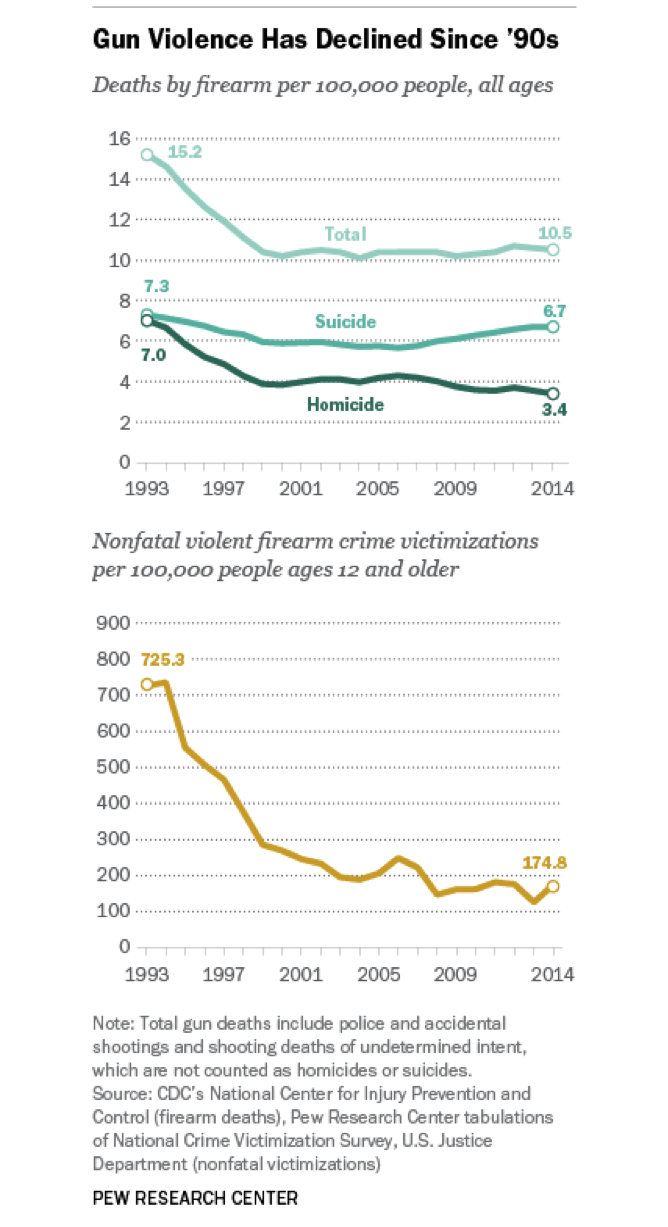
Link: Pew Research – Gun Violence

Article: The Economist
As can be seen clearly in the table above, cities across America have seen a very steady decline in gun violence, whether or not they had any use of ShotSpotter at any time ever.
The implementation of ShotSpotter technology is not what is “causing” the reduction in gun violence any more than SS is “causing” the sun to shine in those cities. But ShotSpotter is more than happy to claim credit for “causing” this reduction which is in reality just part of a decade long macro trend.
ShotSpotter’s claims that it somehow results in a reduction in gun violence are entirely bogus and unsubstantiated.
Disclosure: This article is the opinion of the author.The author is short SSTI. The author may trade one or more securities mentioned within the next 72 hours.


